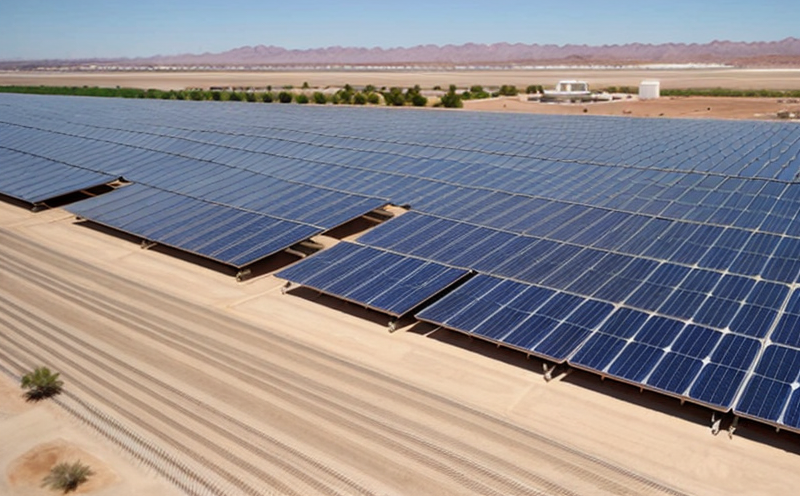ASTM E2152 Performance Rating of Concentrator Photovoltaic Systems
The ASTM E2152 test method provides a standardized approach to evaluating the performance rating of concentrator photovoltaic (CPV) systems. This service is critical in ensuring that CPV systems meet the highest standards of efficiency, reliability, and safety, which are essential for renewable energy projects aiming to maximize output while minimizing costs.
CPV technology uses lenses or mirrors to concentrate sunlight onto photovoltaic cells, significantly increasing the power density incident on the cell. This concentration enhances the system's overall performance but also introduces unique challenges in terms of heat management and spectral response. The ASTM E2152 test addresses these complexities by providing a comprehensive evaluation framework.
The standard defines the protocol for testing CPV systems under controlled conditions, which include:
- Specific concentration ratios
- Different tracking modes (single-axis, dual-axis)
- Varying environmental conditions such as temperature and irradiance levels
- Specified spectral ranges to match real-world solar spectrum
The ASTM E2152 test focuses on the electrical performance of CPV systems by measuring parameters like open-circuit voltage, short-circuit current, maximum power point, and efficiency under defined conditions. This ensures that all CPV systems are evaluated consistently across different manufacturers and environments.
One key aspect of this test is its emphasis on real-world applicability. By simulating various operating scenarios, the ASTM E2152 method helps predict how a CPV system will perform in diverse geographical locations and climatic conditions. This predictive capability is invaluable for optimizing the design and installation processes, thereby enhancing overall system performance.
The test also includes procedures for assessing the thermal management capabilities of CPV systems, which are crucial given the high power densities involved. Effective heat dissipation ensures that CPV cells maintain optimal operating temperatures, preventing degradation over time. This aspect is particularly important in concentrated solar power (CSP) applications where continuous operation at peak efficiency is required.
To ensure accurate and repeatable results, ASTM E2152 specifies precise test procedures including:
- Calibration of the concentration optics
- Installation of the CPV system in a controlled environment
- Application of standard test conditions (STC) or other defined operating parameters
- Data acquisition and analysis using specified protocols
The results from this standardized testing provide manufacturers, engineers, and regulatory bodies with reliable data to make informed decisions about CPV system performance. This not only supports compliance with international standards but also fosters innovation in the renewable energy sector.
By adhering to ASTM E2152, laboratories can offer clients a robust service that enhances their competitive advantage by ensuring high-quality products and processes. The test's focus on real-world application ensures that CPV systems are optimized for maximum efficiency and durability in actual operational settings.
Why Choose This Test
- Standardization: Adherence to ASTM E2152 provides a universally accepted methodology, ensuring consistency across different testing facilities.
- Compliance: By meeting this standard, CPV systems can ensure compliance with international regulations and industry best practices.
- Innovation Support: The comprehensive evaluation provided by ASTM E2152 helps drive advancements in CPV technology through rigorous performance assessments.
The test is particularly beneficial for R&D engineers looking to refine their designs or quality managers seeking to ensure product consistency. For compliance officers, the standardized approach simplifies regulatory adherence and audit processes.
CPV systems are increasingly integral to renewable energy strategies worldwide due to their high efficiency potential. The ASTM E2152 test ensures that these technologies meet stringent performance criteria, thereby contributing to more sustainable and efficient solar power generation.
Customer Impact and Satisfaction
- Enhanced Product Quality: By ensuring CPV systems adhere to ASTM E2152 standards, manufacturers can deliver higher quality products that perform consistently across various conditions.
- Reduced Costs: The standardized testing process helps identify and rectify inefficiencies early in the design phase, reducing development costs and time-to-market.
- Increased Efficiency: Optimized CPV systems can operate at peak performance levels, leading to greater energy output and lower operational expenses.
Customers benefit from these improvements through more reliable products that are less prone to failures. This leads to enhanced customer satisfaction and improved brand reputation for manufacturers. The ASTM E2152 test also supports long-term sustainability goals by promoting the use of efficient, high-performance CPV systems in renewable energy projects.
Use Cases and Application Examples
| Use Case | Description |
|---|---|
| Solar Power Plant Optimization | Evaluating CPV systems for optimal placement in solar power plants to maximize energy output. |
| R&D Prototyping | Testing new CPV technologies under controlled conditions before commercial release. |
| Purchase Verification | Verifying the performance of CPV systems before purchasing for a renewable energy project. |
In CSP applications, the ASTM E2152 test ensures that CPV systems can withstand high power densities and maintain efficiency over extended periods. This is critical in concentrated solar thermal power plants where continuous operation at peak performance is essential.
| Application Example | Description |
|---|---|
| Concentrated Solar Thermal Power Plant | Evaluating CPV systems for their ability to deliver consistent power output in extreme conditions. |
| Research Facility | Supporting research into new materials and designs for CPV systems. |
The use of ASTM E2152 ensures that these applications receive accurate, reliable performance data, which is crucial for both operational efficiency and technological advancement in the renewable energy sector.





